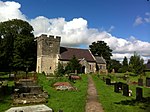Pant-y-Ffynnon Quarry
Geologic formations of WalesQuarries in Wales

Pant-y-Ffynnon Quarry is a stone quarry in the Vale of Glamorgan, Wales, around 3 kilometers east of Cowbridge. It contains fissure fill deposits dating to the Late Triassic (Rhaetian), hosted within karsts of Carboniferous aged limestone, primarily the Friars Point Limestone Formation. Remains of numerous small vertebrates, notably archosaurs, are known from the fissure fills in the quarry, similar to other Late Triassic-Early Jurassic fissure fill deposits known from Southwest England and southern Wales.
Excerpt from the Wikipedia article Pant-y-Ffynnon Quarry (License: CC BY-SA 3.0, Authors, Images).Pant-y-Ffynnon Quarry
Geographical coordinates (GPS) Address Nearby Places Show on map
Geographical coordinates (GPS)
| Latitude | Longitude |
|---|---|
| N 51.458 ° | E -3.374 ° |
Address
CF5 6TQ , Llancarfan
Wales, United Kingdom
Open on Google Maps








